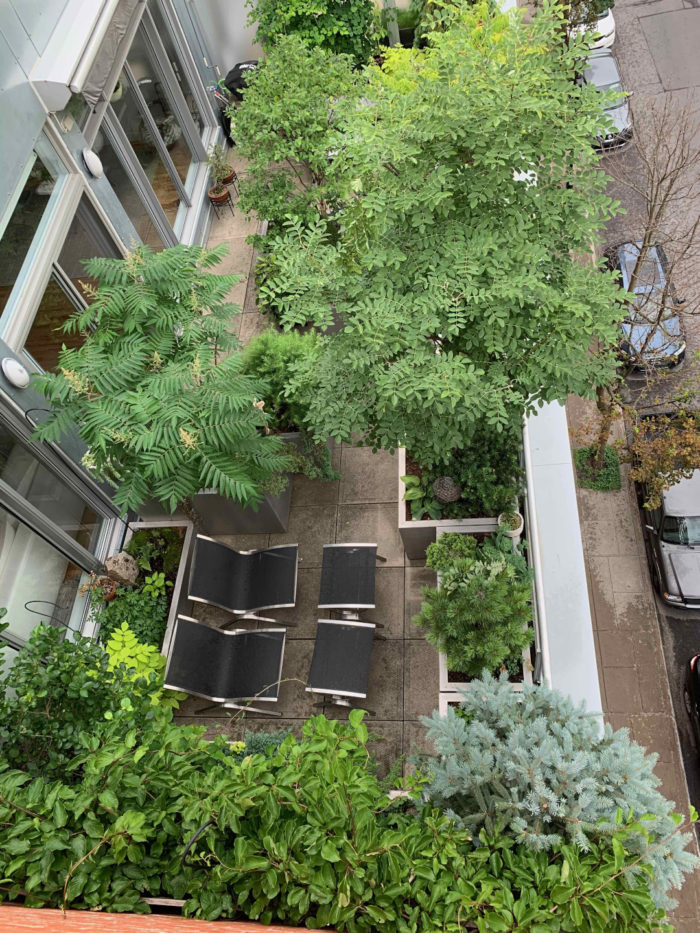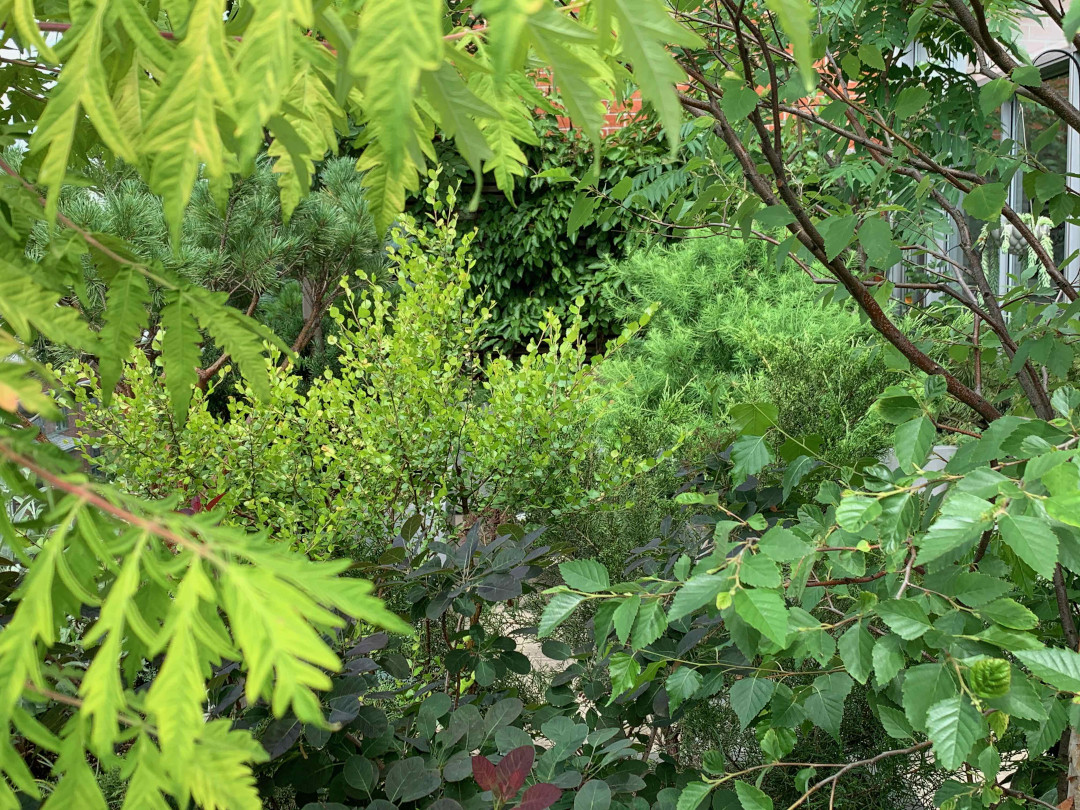Today we’re visiting Julie Hébert’s garden.
I am an avid gardener in an uncommon situation. I live in Montreal, Canada (Zone 5b). When my husband and I bought a loft with a terrace in 2013, I knew I wanted to turn our drab concrete outdoor space into an intimate green nest. I wanted shrubs and trees that I could see maturing year after year, with the freedom to change up the look of the space with perennials. Our climate is not an easy one to work with. In addition to brutally cold winters and scorching heat waves in the summer, Montreal gardeners have to contend with winter temperatures that can fluctuate wildly, more so than those of other southern Quebec cities. Roots in planters are doubly punished because they can’t benefit from the tempering effect of the earth’s heat in the winter. Plants in planters dry out quickly, as they are more exposed to harsh winds. I had my work cut out for me.

Acer palmatum
(Japanese maple, Zones 5–9). Then most Zone 4 plants were eliminated. Interestingly, I found that hardiness zones are not the only deciding factor in plant survival; the Epimedium × rubrum
(red barrenwort, Zones 5–9) that my father gave me last year survived the 2020 winter without a dent, and my three Juniperus squamata
‘Blue star’ have been around for six years. Zone 3 Thuja species, though abundant in our local nurseries, don’t stand a chance on my terrace, even with winter protection.
I generally stick with plants hardy to Zones 3 or colder and have learned to appreciate the beauty of common robust species such as Rhus typhina
(staghorn sumac, Zones 3–9), Picea glauca
(white spruce, Zones 3–6), Betula nana
(dwarf birch, Zones 3–8), and Pinus mugo
(Mugo pine, Zones 3–7). I plant dwarf species whenever possible, or larger ones such as Larix laricina
(tamarack, Zones 2–5) and Tilia cordata
(littleleaf linden, Zones 3–7) that take well to being pruned. I have learned that many dwarf conifer cultivars are grafted and that their root stock may not be as hardy as the species.
Once in a while I try to push my hardiness zone limits, as I have this year with a Cotinus coggygria
‘Velveteeny dwarf’ (smoke bush, Zones 4–9). Its deep red leaves, seen at the bottom of this photo, framed by Thymus pseudolanuginosus
(woolly thyme, Zones 2–8), work well off the cinnamon bark of its neighbor, a Betula nigra
‘Little King’ (dwarf river birch, Zones 4–9). I found that many flowering perennials did not work, as I could not give them enough space to showcase them in mass plantings or drifts as I like to see them.
I learned to work with more subtle qualities in texture and form from small trees, shrubs, and nonshowy perennials. In a small space, it is possible to coordinate to great effect the blue of a single Salix candida
‘Iceberg Alley’ (sageleaf willow, Zones 3–7) with the chartreuse and delicate leaves of a Betula nana
‘Golden treasure’, and the emerald green feathery leaves of a Juniperus chinensis
‘Mint Julep’ (Chinese juniper, Zones 3–9).
I have gained an appreciation for the finer details in the leaves of the various juniper species that thrive in this tiny urban garden. As with any gardener, I suppose, I like to layer plants, so I chose Picea glauca pendula
(weeping white spruce) and Thalictrum rochebruneanum
(meadow rue, Zones 3–8) for their vertical effect, and
Rhus typhina
and Rhus typhina
‘Tiger Eyes’ for their umbrella shape.
I grow
Juniperus procumbens ‘Nana’ (dwarf garden juniper, Zones 3–9),
Juniperus horizontalis (creeping juniper, Zones 3–9), or
Empetrum eamesii ‘Saguenay’ (crowberry, Zones 3–5) for their cascading effects. I use
Thelypteris phegopteris (beech fern, Zones 2–5) and
Cornus canadensis (bunchberry, Zones 2–6) for ground cover, and moss grows all over the place.
I had a sturdy trellis installed (background in this photo) to support an Actinidia arguta
(hardy kiwi, Zones 3–8) couple, which I hope will bear fruit in the next few years as they will soon reach maturity. My Maackia amurensis
(maackia, Zones 3–7) is my largest specimen and offers very welcome shade during the summer. In our climate, we can expect it to grow to 15 feet high in the ground; mine is at 12 feet, and I have started to prune it a bit. I have learned that keeping plants in captivity demands the same responsibilities as keeping a pet cat or dog; they cannot find food on their own, so I need to provide it. Compost won’t do, as we don’t have the invertebrate life to metabolize it. I tried organic hen manure until I found signs of deficiencies in my lime tree and birch. This year I begrudgingly tried a balanced chemical fertilizer and have watched my plants heal and thrive.
As retired baby boomers leave their suburban gardens for smaller city dwellings, the demand for urban container gardens is growing. Growing edibles and annuals are one thing, but growing a garden to accompany us in our old age is a challenge. I am living it and wanted to share my experience with your readers.
Have a garden you’d like to share?
Have photos to share? We’d love to see your garden, a particular collection of plants you love, or a wonderful garden you had the chance to visit!
To submit, send 5-10 photos to gpod@taunton.com along with some information about the plants in the pictures and where you took the photos. We’d love to hear where you are located, how long you’ve been gardening, successes you are proud of, failures you learned from, hopes for the future, favorite plants, or funny stories from your garden.
If you want to send photos in separate emails to the GPOD email box that is just fine.
Have a mobile phone? Tag your photos on Facebook, Instagram or Twitter with #FineGardening!
You don’t have to be a professional garden photographer – check out our garden photography tips!
Do you receive the GPOD by email yet? Sign up here.
Fine Gardening Recommended Products
DeWalt Variable-Speed Cordless Reciprocating Saw
Fine Gardening receives a commission for items purchased through links on this site, including Amazon Associates and other affiliate advertising programs.
You can fit a variety of blades to this saw to cut fallen branches or prune larger limbs from trees in a pinch. It’s fast, tough, easy to use, and extremely versatile.
- 18.31 x 6.13 x 4 inches
- 1-1/8-inch stroke length
- Variable speed trigger with 0-3000 spm
Pruning Simplified: A Step-by-Step Guide to 50 Popular Trees and Shrubs
Fine Gardening receives a commission for items purchased through links on this site, including Amazon Associates and other affiliate advertising programs.
Pruning Simplified shows you exactly how to do it. This must-have guide offers expert advice on the best tools for the job, specific details on when to prune, and clear instructions on how to prune. Profiles of the 50 most popular trees and shrubs—including azaleas, camellias, clematis, hydrangeas, and more—include illustrated, easy-to-follow instructions that will ensure you make the right cut the first time.
The Nature of Oaks: The Rich Ecology of Our Most Essential Native Trees
Fine Gardening receives a commission for items purchased through links on this site, including Amazon Associates and other affiliate advertising programs.
The Nature of Oaks reveals what is going on in oak trees month by month, highlighting the seasonal cycles of life, death, and renewal. From woodpeckers who collect and store hundreds of acorns for sustenance to the beauty of jewel caterpillars, Doug Tallamy illuminates and celebrates the wonders that occur right in our own backyards. He also shares practical advice about how to plant and care for an oak, along with information about the best oak species for your area.






























Comments
LOVED this post !
thank you and enjoy all that you have done!
from France,
cevennes
This has been, by far, my most favorite post!!! Kudos to Julie from your southern neighbor in Ohio, USA!
I just loved your perfect terrace garden, everything is so cleverly thought and balanced.
Bravo from Burgundy, France
Julie -
I especially liked the photo with the cascading plants - like Juniperus procumbens ‘Nana’.
Re: baby boomers leave their suburban gardens for smaller city dwellings
I can identify with that.
Re: I have learned that keeping plants in captivity demands the same responsibilities as keeping a pet cat or dog; they cannot find food on their own, so I need to provide it.
So true.
I liked hearing the details of your container insulation and that you even have kiwi fruit to look forward to.
Incredible attention to detail - thank you for sharing.
What an amazing job you have done creating this gorgeous outdoor city garden space. Love, love, love!
I love your determination! You go girl!😊
Julie, the thoughtful attention to detail in creating, nurturing and caring for your incredible balcony garden is a testament to your tenacity. I am in awe of your eye for visual balance and texture. The challenges of your location have been beautifully met. You are an artist and a magician. I have no doubt that if you wrote a book on what you have learned about balcony gardening in extreme conditions, it would be a bestseller in Montreal bookstores. Kudos!
So true! With all of her experience she could write an excellent book on balcony gardening!
Julie, stumped for words. Your gardens are out of this world!
I love how you've tackled the challenges of city gardening with no land under your feet and yet made a fabulous green sanctuary.
It's so cozy and well designed- from your choice of plants to the custom designed aluminum lined planters to the fountain and the 3 zones you created...wow...and then add years of your experience with trial and error.
If you don’t decide to tackle writing an entire book- then at least Fine Gardening Magazine should hire you to write an article for the print magazine with photos.
I love this garden! Thank you for sharing your knowledge and the lovely photos!
Wonderful! Bravo!
Thank you for the detailed information, but I did wonder how you deal with drainage. The planter boxes look flush with the deck. Assuming drainage holes, does the water pool on your deck or does it drop down from your terrace?
Wow! Thank you all for your generous comments, they are food for my soul :-) Jlamf, I had the boxes pierced with 1/4 inch holes on the bottom, 6 inches apart. I placed a layer of geotextile, then clay balls, then more geotextile before filling with soil. I have changed this technique in a couple of boxes I needed to get fixed when the panels got unstuck (I had to empty them completely-don't get me started...). I realized the roots only occupied about the top 18 inches, so I filled the remaining depths with pieces of styrofoam to lighten the load. The boxes are slightly elevated with about 1/2 feet. The water drains between the floating concrete slabs into a drain, which happens to be on my neighbour's terrace. I am meticulous about picking up leaves and soil to avoid blocking the drain and having the condo association blame me for water damage. Once a year, I remove the concrete slabs to which I have access to, and shop vac the roof lining. I keep photos as proof. Thanks again everyone!
What an incredible and awe inspiring post! Thank you for all the detail you included, even adding to it in your above reply. I agree that I'd like to see a full article in Fine Gardening with diagrams and photos. Your planters are beautiful - what type of artist did you find to build them? You have really risen to the top in technical and artistic design. Kudos!
Hello, thank you again for all your encouragement. Finding someone to build the boxes was no easy task, to my surprise. I had designed the boxes over our first winter, sitting in front of a snowy space for long periods, trying to visualize my future garden. I called the obvious nurseries and design companies to have the boxes built to my specifications, to no avail. Frustrated, I contacted a company that makes road signs. I figured they had the workshop to cut and glue the aluminum I wanted. It worked!
Great post, so informative.
Thanks for posting and taking the time to explain.
Love GPOD posts that are more than just pretty pictures.
Wow! Just wow! You've shown us all how to transform a drab, lifeless space into a sacred, intimate sanctuary. Thank you for the awe inspiring pictures and detailed back story. I bet your neighbors are green with envy!
Julie, I love the sanctuary you created! Not only did I learn lots from your garden story but i'm pretty inspired by the planning, design, plant specimens and combinations. If I ever visit Montreal again, I wish I could walk by your garden and oggle. Thank you.
Thank you again everyone for all your positive comments. It is my first time posting here and it has been a very pleasant experience. Cheers to you all,
Julie
I thank you for posting great pictures along with so much information about the process of building your beautiful space. Your vision for creating the garden's spatial design, building the insulated planter boxes, trial and error with plant choices, and learning what works must be very satisfying. Your resulting terrace garden attests to years of experience and ambition and now you are enjoying great results. Well done.
Log in or create an account to post a comment.
Sign up Log in